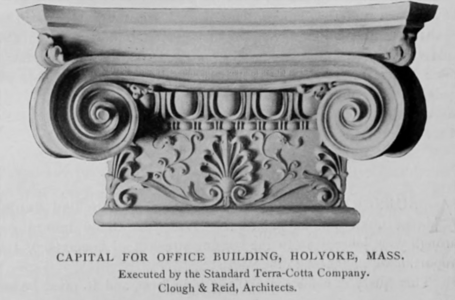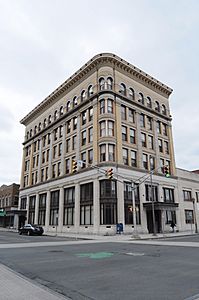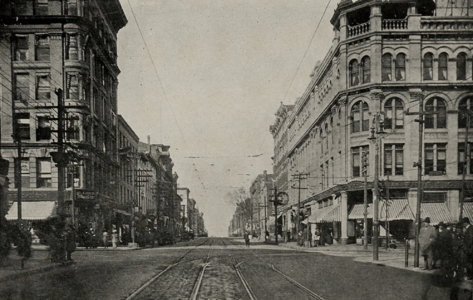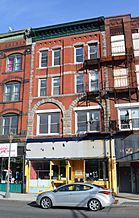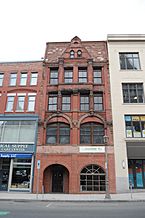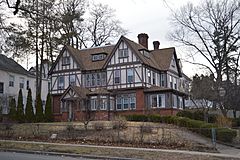James A. Clough facts for kids
Quick facts for kids
James Amasa Clough
|
|
|---|---|
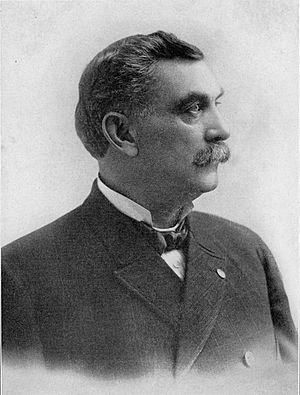 |
|
| Born | January 24, 1850 |
| Died | May 22, 1917 (aged 67) |
| Resting place | Forestdale Cemetery Holyoke, Massachusetts |
| Nationality | American |
| Education | Massachusetts Institute of Technology |
| Known for | Architect |
| Political party | Republican |
| Spouse(s) |
Elnora Celestia Shaw
(m. 1871) |
| Children | 3 |
| Signature | |
James Amasa Clough (born January 24, 1850 – died May 22, 1917) was a talented American architect. He was also a carpenter and a builder. James Clough was very active in New England, especially in Western Massachusetts. His designs greatly shaped the look of Holyoke in the late 1800s and early 1900s.
He designed many important buildings in Holyoke. These included the Holyoke Public Library and the Canoe Club. He also designed the Mount Tom Summit House. After 1890, he formed a company called Clough & Reid with William B. Reid. James Clough led this company until he retired in 1907. Another one of his students, George P. B. Alderman, also became a famous architect.
Contents
James Clough's Early Life and Family
James Clough was born in Chicopee on January 24, 1850. His parents were James and Cordelia Clough. He went to school until he was 15 years old.
When the Civil War started, he joined the army. He served in Company B of the 39th New Jersey Volunteer Infantry. He was part of battles like the Siege of Petersburg. During the war, he got sick with an illness and sunstroke. He had to go to a hospital for treatment. He stayed in the army until the war ended.
After the war, he moved to Holyoke in 1870. He arrived with no money and started working as a carpenter.
His Marriage and Education
On July 5, 1871, James Clough married Elnora Celestia Shaw. Elnora was a school teacher. She taught in Prescott, Greenwich, and Holyoke.
Around this time, James started working as a building contractor. He wanted to learn more and become an architect. He worked during the day. At night, Elnora helped him study for his entrance exams. He wanted to get into the Massachusetts Institute of Technology (MIT). After finishing his studies in Boston, he returned to Holyoke. He then started his own architecture business.
Community Involvement
James Clough was active in many community groups. He was a member of the local Republican Party. He also belonged to the Grand Army of the Republic, a group for Civil War veterans. He was a member of the Mount Tom Lodge A.F. & A.M. and the Independent Order of Odd Fellows. He was also part of the Boston Society of Architects.
Besides his architecture work, he was a trustee for the Holyoke Savings Bank. James Clough passed away at his home in Holyoke on May 22, 1917. He was buried in Forestdale Cemetery.
James Clough's Architectural Career
James Clough designed many different types of buildings. He designed homes, like the one for Mayor Arthur B. Chapin. He also designed large business buildings. His firm had a big impact on Holyoke. They also worked on homes in other towns in the Connecticut Valley.
One of his first important projects was a hotel for John Delaney. This hotel was called Delaney's Marble Block or the Marble Hall Hotel. Clough designed it, and it was built in 1885. The building stood for over 60 years. It was torn down in 1950 to make way for a new building.
- Clough's North High Street Gateway
Buildings on High Street
Some of Clough's buildings still stand on High Street today. One is the Latino Professional Building. It was first called the Ball Block. It was built in 1898 for a druggist named Charles Ely Ball.
In 2005, the building was updated. It was renamed The Latino Professional Building. It even won an award for keeping its original details. The building shows Clough's interest in Italianate style. You can see this in its special corner windows and fancy capitals and cornices.
Clough also designed other business buildings on High Street. These include the Clough Building and the Baker Building. The Clough Building is also known as the Russell-Osborne building. The Baker Building was built for a stove and furnace business.
Clough's designs often used Richardsonian Romanesque style. This can be seen in the stone arches on the second floors of these buildings. Both buildings were built around the same time, in 1885 and 1886.
Public Buildings and Legacy
Clough also designed many public spaces. One was the Holyoke Canoe Club, built in 1898. It had an Italianate style with towers. The building is still used today in Smith's Ferry.
Perhaps Clough's most famous work is the Holyoke Public Library building. It was built in 1902. Clough designed it for free because his daughters loved the library.
His last major project was also done without pay. He designed the Holyoke Home for the Aged in 1911. This facility still helps senior citizens today as the Sarawood Retirement Community.
Selected Works by James Clough
James Clough and his firm, Clough & Reid, designed buildings in many places. In Massachusetts, they worked in Boston, Springfield, Westfield, and other towns. They also had projects outside of Massachusetts. These included places like Rutland, Vermont, and Keene, New Hampshire. They even worked as far away as Dayton, Ohio.
Buildings in Holyoke
- Delaney's Marble Block (1885), torn down in 1950
- Clough Building/Russell-Osborne Building (c. 1885)
- Baker Building (1886)
- Arthur B. Chapin House (1897)
- Mount Tom Summit House (1897, rebuilt 1901), destroyed by fire in 1929
- Holyoke Canoe Club (1898)
- Holyoke Public Library (1902)
- Holyoke Home for Aged People (Sarawood) (1911)
Buildings in Other Cities
- William A. Burnett House in Amherst (1897)
- Henry J. Beebe House in Springfield (1890), torn down c. 1925
- Highland Brewing Company Building in Springfield (1897)
- Ryan-Methe Building in Springfield (1898)


